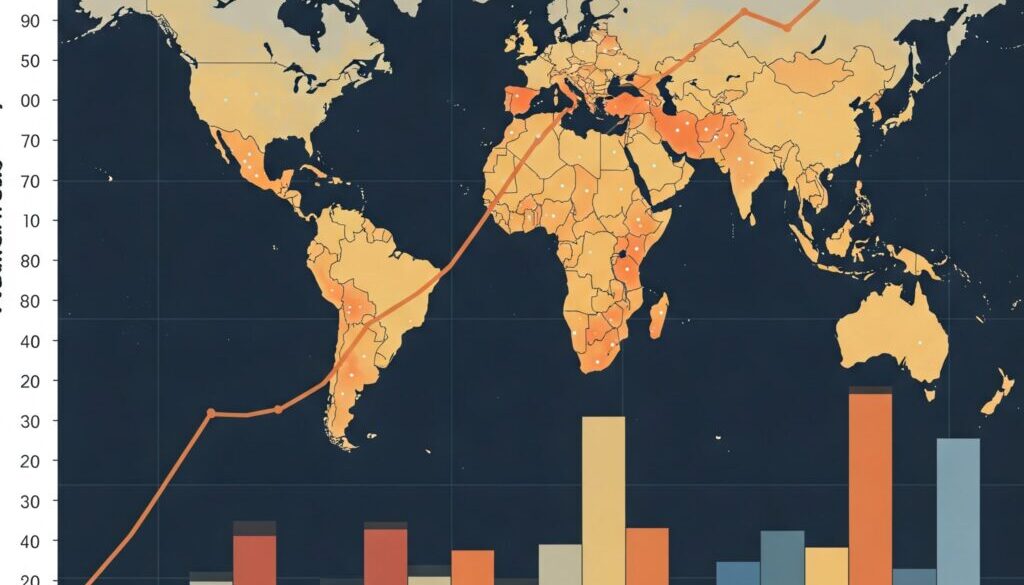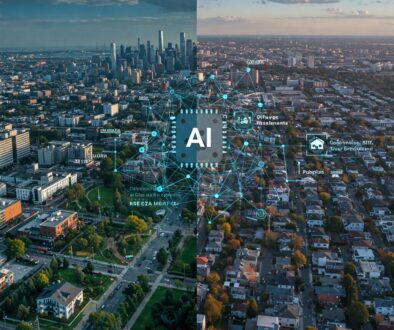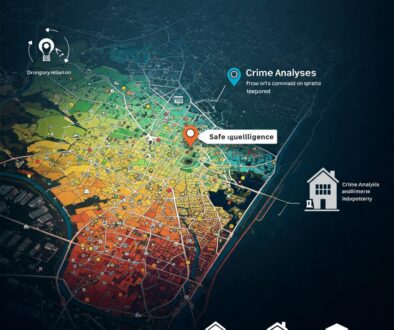Predicting Property Value Growth: How GeoIntelligence Maps Future Potential
The real estate market has always been driven by the famous mantra: location, location, location. What’s changing in 2025 is our ability to quantify, analyze, and predict exactly how location will influence property values over time. Traditional approaches to predicting property appreciation relied heavily on historical sales data, broad market trends, and expert opinions – methods that often missed emerging patterns and hyperlocal factors that drive significant value changes.
Today, AI-powered geospatial intelligence platforms like Locas.dev are revolutionizing how investors identify properties with exceptional growth potential, sometimes spotting tomorrow’s hot neighborhoods years before traditional analysis would reveal them.
Why Traditional Value Prediction Methods Fall Short
Conventional approaches to predicting property appreciation typically involve:
- Analysis of recent comparable sales (“comps”)
- Broad neighborhood trend evaluation
- Demographic data review at city or zip code level
- Market cycle timing considerations
- Expert opinions from local real estate professionals
While these methods provide some insight, they have significant limitations:
- Too retrospective: They primarily look at what has already happened
- Too broad: They often miss micro-neighborhood trends
- Too subjective: They rely heavily on individual interpretation
- Too limited: They consider only a fraction of relevant factors
- Too slow: They typically identify trends only after they’re well established
How GeoIntelligence Creates Value Growth Maps
Modern geospatial intelligence platforms use AI to create multidimensional models of potential property value growth by analyzing:
1. Hyperlocal Development Patterns
AI systems track subtle signals of neighborhood transformation:
- Building permit clusters indicating renovation and development momentum
- Business license applications revealing commercial investment patterns
- Property ownership changes showing investor or homeowner interest
- Renovation frequency analysis identifying upgrading patterns
- New construction style evolution pointing to neighborhood positioning changes
“We identified a small pocket in Nashville that showed early-stage gentrification patterns through clustering of high-value renovation permits,” explains David Chen of Horizon Capital. “Two years later, property values in that micro-neighborhood had increased 43% compared to 12% in the broader area. The AI spotted the pattern before it became obvious to traditional analysts.”
2. Infrastructure Development Impact Modeling
AI evaluates how planned and in-progress infrastructure projects will affect property values:
- Transportation improvements and their accessibility impacts
- Utility upgrades enabling new development types
- Public facility investments enhancing area amenities
- Green infrastructure projects improving livability
- Smart city initiatives attracting technology-oriented residents
The system doesn’t just identify these projects but models their specific impact on property values based on historical patterns from similar improvements elsewhere.
3. Economic Gravity Analysis
One of the most powerful predictive approaches involves analyzing “economic gravity” – how economic forces pull development and value in certain directions:
- Job creation patterns showing where employment is growing
- Income growth hotspots revealing increasing spending power
- Business formation clusters indicating economic vitality
- Commercial rent evolution predicting business migration patterns
- Investment flow analysis tracking where capital is concentrating
By combining these indicators, AI systems can predict how economic momentum will transform neighborhoods, often before visible signs appear.
4. Social Dimension Mapping
The social characteristics of a neighborhood significantly impact its desirability and value trajectory:
- Educational performance trends beyond simple school ratings
- Crime pattern evolution showing improving safety profiles
- Community engagement levels indicating neighborhood cohesion
- Cultural amenity development revealing lifestyle improvements
- Demographic shift analysis identifying changing resident profiles
“What’s remarkable is how the AI identified subtle shifts in the types of businesses opening in a formerly industrial area of Portland,” notes urban planner Sarah Johnson. “The pattern of small art galleries, craft breweries, and co-working spaces appeared insignificant individually, but together they signaled a transformation that ultimately led to residential value increases of over 60% in three years.”
5. Environmental Improvement Trajectories
Environmental factors increasingly drive property values, and AI can identify emerging positive trends:
- Air quality improvement patterns from policy or technology changes
- Green space development and enhancement projects
- Brownfield remediation initiatives converting liabilities to assets
- Urban tree canopy expansion improving livability
- Flood mitigation investments reducing risk profiles
Case Study: The Riverfront District Transformation
When Meridian Investment Group was evaluating a potential acquisition in a seemingly stagnant industrial district, traditional analysis suggested modest growth potential at best. However, Locas.dev’s GeoIntelligence platform painted a very different picture:
- Infrastructure Analysis identified planned pedestrian bridge improvements that would connect the area to a thriving downtown
- Permit Clustering showed a 218% increase in renovation permits in a specific six-block radius
- Business Formation Patterns revealed a shift from industrial to creative and technology businesses
- Environmental Improvements included a funded riverfront restoration project
- Economic Gravity showed spillover effects from nearby tech company expansions
Based on this analysis, Meridian acquired several properties in the area. Within 24 months, property values increased by 37%, significantly outperforming the broader market, as the AI-identified transformation accelerated.
The Five Dimensions of Value Growth Prediction
Today’s most sophisticated GeoIntelligence platforms evaluate properties across five key dimensions to create comprehensive value growth predictions:
1. Physical Transformation Potential
- Underutilized density analysis – identifying properties with development potential
- Architectural significance assessment – recognizing unique characteristics with value potential
- Structural improvement opportunities – evaluating renovation upside
- Land use optimization potential – identifying higher and better uses
- Physical constraint reduction – recognizing when limitations are being removed
2. Accessibility Evolution
- Transit network expansion models – projecting improved connectivity
- Walkability improvement projections – identifying pedestrian infrastructure enhancements
- Digital connectivity advancement – tracking technology infrastructure upgrades
- Service proximity development – monitoring new amenity additions
- Transportation mode shift analysis – identifying changes in how people move
3. Economic Momentum
- Investment density mapping – tracking capital concentration
- Commercial activity diversification – monitoring business ecosystem health
- Income growth patterns – identifying increasing local wealth
- Property turnover acceleration – recognizing increased market interest
- Commercial rent trajectory analysis – predicting business migration
4. Regulatory Landscape Shifts
- Zoning change probability assessment – identifying likely regulatory evolution
- Development incentive analysis – monitoring government encouragement
- Approval time trends – tracking bureaucratic streamlining
- Policy direction modeling – projecting regulatory trajectories
- Public investment prioritization – identifying government focus areas
5. Sentiment and Perception Evolution
- Media coverage sentiment analysis – tracking changing area perception
- Social media location mentions – monitoring public interest growth
- Search volume trends – identifying increasing online research
- Tourism and visitor pattern analysis – recognizing external interest
- Demographic appeal evolution – identifying broadening market appeal
Implementing GeoIntelligence in Your Investment Strategy
To leverage these predictive capabilities in your real estate investment approach:
1. Look Beyond Current Value to Growth Potential
The highest-returning investments often aren’t in already-established prime areas but in locations on the verge of transformation. AI can identify these emerging opportunities before they’re obvious.
2. Match Growth Patterns to Your Investment Timeline
Different areas show different growth trajectories. Use AI predictions to match locations with your specific investment horizon, whether short-term or long-term.
3. Layer Multiple Positive Indicators
The most reliable growth predictions occur when multiple positive factors align. Look for properties where several growth indicators converge.
4. Monitor Prediction Accuracy Over Time
Track how AI predictions perform against actual outcomes to calibrate your trust in specific models and refine your approach.
5. Combine AI Insights with Local Knowledge
The most successful investors use AI predictions as a powerful complement to—not a replacement for—their market understanding and on-the-ground observations.
The Future of Value Growth Prediction
As GeoIntelligence platforms continue to evolve, several emerging capabilities promise even more powerful predictive models:
- Real-time growth indicator monitoring with continuous model updating
- Personalized growth predictions based on your specific investment criteria
- Alternative scenario modeling showing different potential futures
- Cross-market pattern recognition identifying emerging trends from other cities
- Policy impact simulation predicting how regulatory changes will affect values
Conclusion: The Competitive Edge of Predictive GeoIntelligence
In today’s competitive real estate market, the ability to accurately predict value growth patterns provides a decisive advantage:
- Identifying opportunities before they’re widely recognized
- Making more confident acquisition decisions backed by data
- Optimizing entry and exit timing based on growth trajectories
- Focusing development efforts in areas with strong appreciation potential
- Building portfolios with complementary growth patterns for consistent returns
The most successful real estate investors of 2025 and beyond will be those who combine traditional market knowledge with the predictive power of AI-driven GeoIntelligence.
Ready to discover the hidden growth potential in your target market? Try Locas.dev today and see how GeoIntelligence can transform your property value predictions.
This article reflects the current state of AI technology in property value prediction. For the latest updates and features, visit Locas.dev.
Keywords: property value prediction, real estate growth forecast, AI property appreciation, geospatial intelligence real estate, neighborhood growth prediction, property investment analytics, future value mapping



